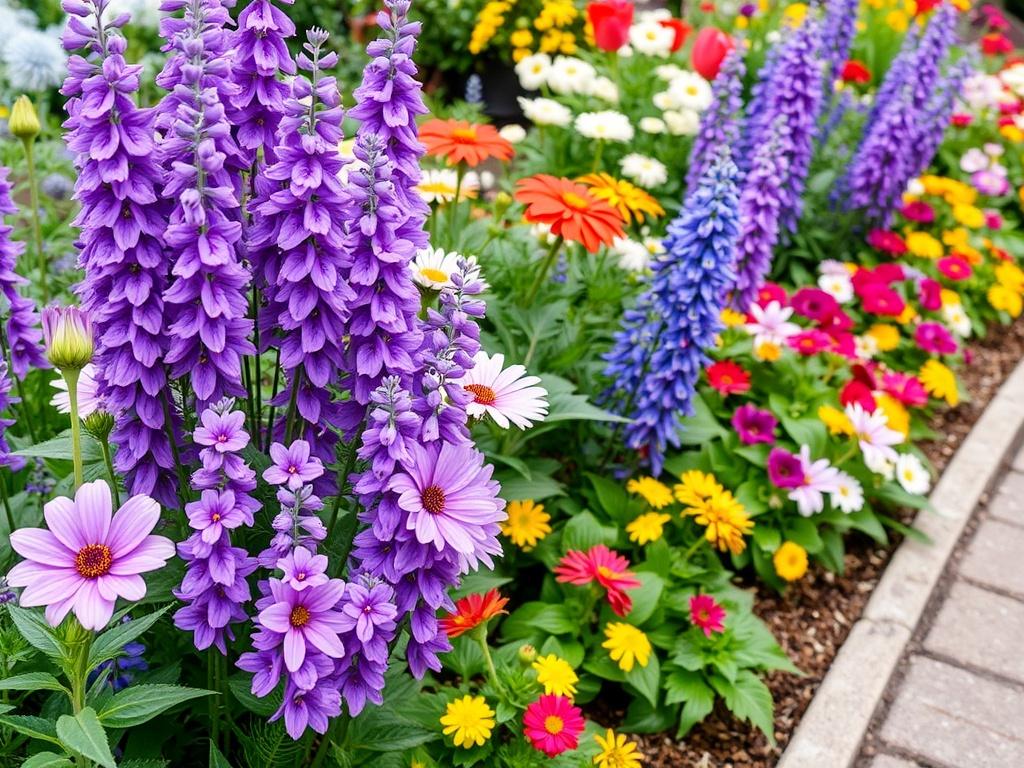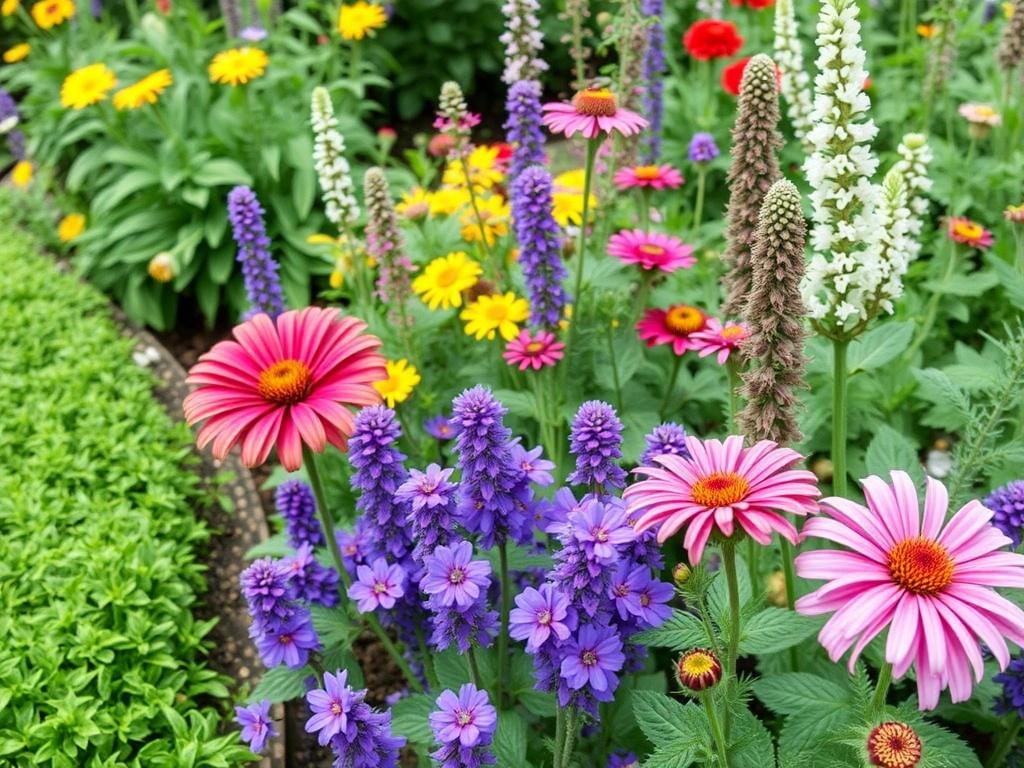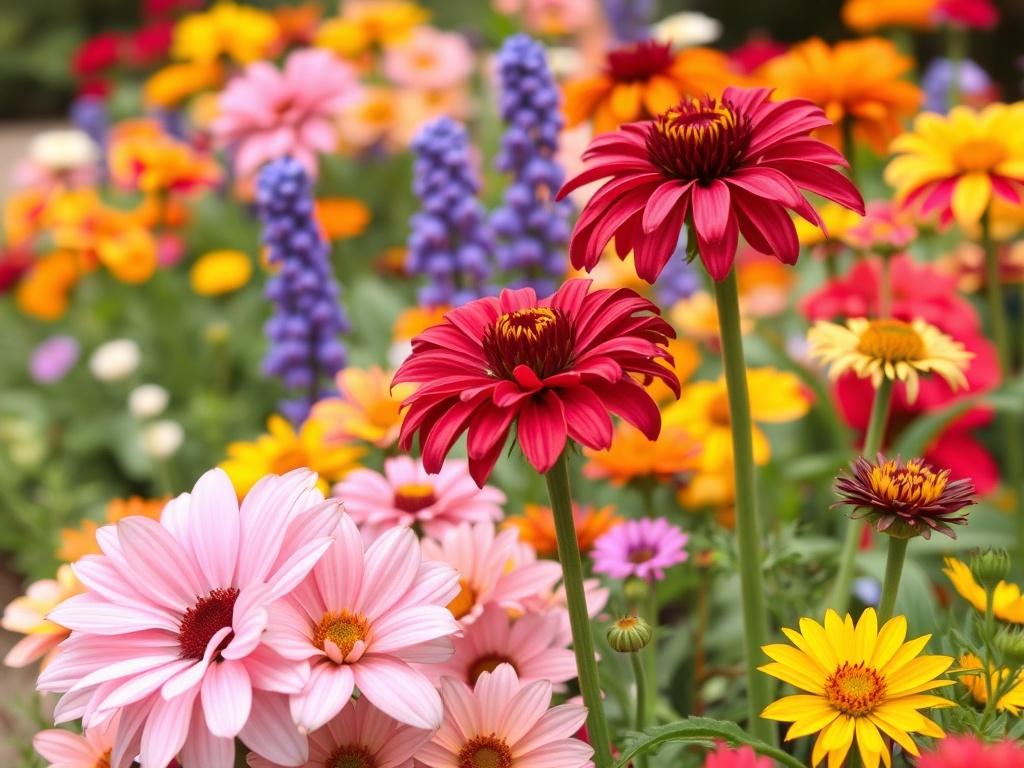Growing a perennial flower bed that offers color and interest in every month is one of the most satisfying gardening challenges. Imagine stepping into your garden and seeing blooms, textures, and shapes that change with the seasons but never leave a dull period. It takes planning, plant knowledge, and some patience, but the result is a living painting that evolves continuously rather than vanishing into blank beds every winter. In this article I’ll walk you through the mindset, the practical steps, plant choices, and maintenance routines you need to build a resilient, beautiful perennial bed that provides flowers, foliage, and structure all year round.
I’ll keep things conversational and practical, so whether you’re planting your first perennial bed or upgrading an old one, you’ll have clear, usable guidance. We’ll cover site selection, soil preparation, seasonal plant layers, design principles, maintenance calendars, layout examples, and trouble-shooting tips. I’ll suggest plant lists appropriate for a temperate climate (with notes for colder or warmer areas), show how to layer for continuous bloom, and give a few theme ideas you can adapt to your space and style. Let’s get started—thinking like a gardener who designs for months, not just one glorious week of bloom.
Understanding the Goal: What “Year-Round” Really Means
Before you choose plants, clarify what “flowering all year” means for you. In many regions true bloom in every single month is hard without greenhouse-grown exotics. But for a practical, beautiful garden we aim for continuous visual interest: at least one plant in flower every month, plus attractive foliage, seedheads, or architectural elements during quieter months. In other words, bloom is the headline, but texture and structure are the supporting cast.
The bed should include:
- Spring star performers (bulbs, early perennials).
- Summer mainstays (long-blooming perennials and shrubs).
- Autumn showpieces (late perennials and asters).
- Winter interest (evergreens, seedheads, bark, and dried flower forms).
Mixing these elements gives continuity: while one plant finishes, another starts. You also get pollinator support across seasons and a more natural rhythm in the garden.
Site, Soil, and Climate: The Foundation
Know Your Site
Start by observing sunlight, wind, drainage, and microclimates. How many hours of sun does the spot get? Is it hot and reflective next to a driveway, cooler under a tree, or sheltered by a wall? Map this out mentally or on paper. A bed in full sun needs different plants than one in dappled shade.
Test and Improve the Soil
Perennials reward good soil. A simple soil test (pH, organic matter, drainage) will tell you what to fix. In heavy clay, add compost and grit for structure and drainage. In sandy soil, add organic matter to hold moisture. Most perennials prefer fertile, well-drained soil with steady moisture. If your soil is poor, build raised beds or import topsoil mixed with compost.
Match Plants to Climate Zones
Know your USDA or Köppen zone equivalents, but also think microclimate. Frost pockets, coastal humidity, and urban heat islands all affect what will survive and when it will flower. If you live in a very mild climate, some traditionally spring bulbs may be unreliable; in cold climates, choose hardy species and rely on shrubs and seedheads for winter structure.
Design Principles for Continuous Bloom
Layering by Bloom Time
Think vertically and temporally. Plant a mix of:
- Bulbs and low early bloomers for spring (tulips, alliums, crocus, grape hyacinth).
- Short perennials and groundcovers for early season fills (celandine poppy, saxifraga).
- Mid and tall perennials for summer (salvia, coneflowers, rudbeckia).
- Late-season asters and sedums for autumn.
- Structural shrubs, ornamental grasses, and evergreens to carry through winter.
By overlapping bloom periods, you reduce gaps.
Repetition and Rhythm
Use a few reliable repeaters—plant the same species or color at intervals to create visual rhythm. Repetition helps the eye travel through the bed and avoids the chaotic “mishmash” look many beginners fall into.
Color and Contrast
Plan a color story. You can opt for a harmonious palette (blues, purples, whites) or high-contrast pops (hot pink and yellow). Keep seasonal cohesion by choosing plants whose colors work together across months. Foliage color (silver, burgundy, chartreuse) is as important as flowers.
Form and Texture
Mix leaf shapes and plant forms: mounded perennials next to upright spikes, airy veronica next to bold hosta leaves. Seedheads and grasses add motion and winter texture.
Height and Front-to-Back Planning
Arrange tall plants at the back, mid-height in the center, and groundcovers at the front. If the bed is island-style (viewed from all sides), place taller plants in the center and tier outward. Keep sightlines and plant proportions in mind.
Choosing Plants by Season: Practical Lists
Below is a practical seasonal breakdown for a temperate climate. Replace specific species with local equivalents if you’re in a different climate. The goal is to choose at least one reliable bloomer per month and use foliage/structure to bridge quieter times.
Spring (March–May)
- Bulbs: Crocus, Grape Hyacinth (Muscari), Daffodils, Tulips, Alliums.
- Early perennials: Pulmonaria, Corydalis, Hellebores, Primula.
- Groundcovers: Aubrieta, Lamium for shade, Veronica.
Early Summer (June)
- Peonies, Oriental Poppies, Irises.
- Salvia, Nepeta (catmint) just starting; many will bloom into summer.
High Summer (July–August)
- Core long-bloomers: Echinacea (coneflower), Rudbeckia, Phlox, Daylilies.
- Perennial salvias, Gaura, Liatris, Penstemon.
- Companion shrubs: Lavenders, small flowering shrubs like Caryopteris.
Late Summer to Autumn (September–October)
- Asters and Michaelmas daisies, Sedums (autumn joy), Anemone hupehensis, Chrysanthemums.
- Ornamental grasses reach their peak and seedheads add interest.
Winter Interest (November–February)
- Evergreens: small shrubs and boxwood for structure.
- Grasses with seedheads (Miscanthus, Calamagrostis), Sedum seedheads, Echinacea seedheads.
- Bark interest from shrubs: Cornus (dogwood) with colorful stems; stem textures of birch or barberry.
Year-Round Bloom Strategy
To get true continuity, include:
- Early bulbs and hellebores for late winter/early spring.
- Phased bloomers like Nepeta and Salvia that rebloom with cutting.
- Late-summer stalwarts (asters and sedums) to finish the year strong.
- Winter structure with grasses and evergreens to avoid dead space.
Illustrative Plant Calendar Table
| Month | Key Bloomers | Supporting Interest | Notes |
|---|---|---|---|
| January–February | Hellebores | Evergreens, bark, seedheads | Best in mild winters; otherwise rely on seedhead interest |
| March–April | Crocus, Daffodils, Early perennials | Fresh foliage emerging, bulbs | Bulbs provide a spring burst before perennials fill in |
| May–June | Peony, Iris, Allium | Leafy mounds, early shrubs | Peonies are showy but short-lived; combine with longer-blooming plants |
| July–August | Echinacea, Rudbeckia, Phlox | Lavender, Nepeta | Peak of color—deadhead to prolong bloom |
| September–October | Asters, Sedum | Ornamental grasses, seedheads | Important months for pollinators and late-season color |
| November–December | Late sedums, some chrysanthemums (mild areas) | Grasses, evergreen silhouettes | Focus on texture and structure rather than prolific bloom |
Practical Design Examples (Five Themes)
I’ll give five practical design ideas. Each includes a short plant list and a note on style and maintenance so you can adapt them to your garden.
Cottage-Style Perennial Bed
- Core plants: Peony, Phlox, Nepeta, Echinacea, Rudbeckia, Lupin (early), Alliums (spring bulbs)
- Accents: Climbing roses on supports, Hollyhocks, Campanula
- Style notes: Dense planting with staggered heights, lots of repetition, informal edges.
- Maintenance: Moderate—deadhead, thin every 2–3 years, watch for powdery mildew (especially phlox).
Low-Maintenance, Drought-Tolerant Bed
- Core plants: Salvia, Lavender, Sedum, Achillea, Echinacea, ornamental grasses (Festuca, Stipa)
- Accents: Cistus, low shrubs like Russian sage if zone-appropriate
- Style notes: Use gravel mulch, lean into leaf color and long bloomers.
- Maintenance: Low—requires good drainage and minimal watering once established.
Shade and Woodland Perennial Bed
- Core plants: Hosta, Ferns, Heuchera, Pulmonaria, Astilbe, Trillium for spring if local
- Accents: Woodland bulbs (scilla, camassia), shrubs like Hydrangea (varieties for shade)
- Style notes: Emphasize foliage contrast and dappled light; flowers are secondary but beautiful.
- Maintenance: Moderate—keep soil moist, mulch well, divide hostas periodically.
Modern Minimalist Perennial Bed
- Core plants: Agastache, Salvia, Echinacea, ornamental grasses, boxwood or clipped hedges
- Accents: Architectural succulents where climate allows, limited palette of 3–4 plants repeated
- Style notes: Clean lines, repetition, limited colors and textures for a strong statement.
- Maintenance: Moderate—tidy deadheading and occasional replanting to keep the graphic look.
Pollinator-Friendly Perennial Bed
- Core plants: Lavandula (lavender), Buddleia (butterfly bush), Echinacea, Asters, Sedums, Salvia
- Accents: Native perennials and shrubs, undisturbed leaf litter patches for insects
- Style notes: Plant for successive nectar sources, avoid pesticides.
- Maintenance: Moderate—deadheading selectively to balance seed production for birds and continued bloom.
Comparing Design Options

| Design | Best for | Maintenance Level | Year-Round Interest |
|---|---|---|---|
| Cottage | Informal gardens, abundance of color | Moderate | High (many spring & summer bloomers) |
| Drought-tolerant | Hot, sunny, poor soil | Low | Good (focus on long bloomers & grasses) |
| Shade | Under trees, north-facing areas | Moderate | Fair (focus on foliage + spring bulbs) |
| Modern | Contemporary homes, small beds | Moderate | Good (structure + repeated plants) |
| Pollinator | Wildlife gardens, ecological focus | Moderate | High (sequenced nectar sources) |
Seasonal Care and Maintenance Tips
Designing is half the battle—maintenance ensures continuous bloom. Here’s a practical seasonal to-do list, plus evergreen practices.
Evergreen Practices
- Watering: Deep, infrequent watering encourages strong roots. Young plantings need more frequent watering until established.
- Mulch: 5–8 cm (2–3 in) of organic mulch keeps roots cool, retains moisture, and suppresses weeds. Renew yearly.
- Fertilizing: A balanced slow-release in spring and a light top-dressing of compost mid-season keeps plants vigorous.
- Deadheading: Remove spent flowers on reblooming perennials to encourage more flowers.
- Staking and support: Use unobtrusive supports for tall perennials to prevent flop during heavy rains.
Spring Tasks
- Clear winter debris and cut back dead stems, leaving some seedheads for birds if desired.
- Divide overcrowded clumps (peonies rarely divide; hostas and asters every 3–5 years).
- Top up mulch, check soil drainage, and amend as needed.
Summer Tasks
- Deadhead to prolong blooms, but leave some late-season flowers for pollinators.
- Water deeply during heat spells; morning watering reduces disease risk.
- Cut back early-blooming shrubs once they finish to tidy and encourage new growth.
Autumn Tasks
- Let hardy seedheads stand for winter interest and wildlife food—cut in spring.
- Lift tender perennials and bulbs if needed for your zone.
- Plant bulbs for spring and top up compost around perennials for winter protection.
Winter Tasks
- Minimal work—remove only hazards. Protect tender plants with extra mulch or burlap if needed.
- Plan next year: note successes and failures in your garden journal.
Planting Plan: Step-by-Step
A clear sequence helps new beds establish quickly.
- Prepare the bed: remove weeds, dig in plenty of compost, and break up compacted soil.
- Place plants while still in pots to experiment with composition—step back and view from different angles.
- Plant taller anchors first, then mid-size, then edges and groundcovers.
- Water thoroughly at planting and add a layer of mulch to conserve moisture.
- Monitor closely for the first season—adjust watering and move any underperformers if necessary.
Common Problems and How to Fix Them

Pests and Diseases
Most perennial beds face occasional pest problems: slugs on hostas, aphids on young shoots, powdery mildew on phlox. Tackle problems early:
- Encourage beneficial insects (ladybugs, lacewings) by planting pollinator flowers.
- Use physical barriers (copper tape for slugs) and hand-pick pests when practical.
- Improve air circulation and avoid overhead watering to reduce fungal diseases.
Gaps in Bloom
If you find blanks in summer or late winter, plugin quick fixes:
- Annuals like cosmos or zinnias can fill summer gaps nicely in borders.
- Plant additional early bulbs or shrubs with staggered bloom times to bridge tricky months.
Overcrowding and Leggy Growth
Perennials that aren’t divided will crowd and produce fewer blooms. Divide every few years and trim back in mid-season to promote compact rebloomers (try cutting nepeta and salvias by about one-third in midsummer to encourage new flowers).
Tools, Materials, and Where to Invest
Good tools and materials make the work joyful and efficient.
- Spade, fork, and hand trowel for planting and dividing.
- Quality pruning shears and loppers.
- Mulch, compost, and a soil test kit.
- Supports: plant rings, bamboo canes, or unobtrusive metal frames for tall perennials.
- Notebook or garden app to track what blooms when—this will inform future plant choices.
Adapting to Your Landscape and Budget
You don’t need to spend a fortune to achieve continuous bloom. Start small and expand. Buy a few perennials each season and divide them to populate the bed. Swap plants with friends or trade cuttings. If budget allows, invest in a few woody anchors (small shrubs, reliable grasses) because they add structure that can’t be bought cheaply season after season.
Also adapt designs to your yard: a north-facing strip will need shade lovers, while a courtyard receives reflected heat and needs drought-tolerant plants. Don’t force a plant that doesn’t suit your site—choose the right plant for the right place, and the bed will reward you with low-maintenance success.
Keeping It Fresh: Evolving Your Bed
A perennial bed is never “done.” Each season teaches you more about what works and what doesn’t. Keep a simple journal: note bloom times, color clashes, pests, and spots that stay soggy or scorch. At the end of the first year, you’ll know which plants to move, remove, or multiply. In the second and third years you’ll see the rhythm settle. Embrace small tweaks rather than wholesale overhauls—plants mature and change, and the best gardens evolve gracefully over years.
Conclusion

Designing a perennial bed that blooms all year is a delightful balance of planning and play. Start with a clear sense of your site, build a soil-rich foundation, and select plants that collectively provide spring bulbs, summer stalwarts, autumn finishers, and winter structure. Use repetition, varied textures, and overlapping bloom times to create continuity, and adopt seasonal maintenance habits—mulching, deadheading, dividing—that keep the bed healthy and productive. With patience and observation you’ll learn what your garden prefers; over seasons you’ll enjoy a living tapestry that grows richer with time, offering flowers for months, shelter for wildlife, and a deep, calming pleasure every time you step outside.



